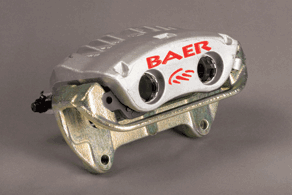
While calipers need to convert hydraulic fluid pressure into clamp force, they also must look good doing it. A little advertising never hurts either. Can you guess the manufacturer of this caliper? (Randall Shafer/Baer)
In recent years, brake calipers have transformed into a prominent automotive accessory for the image-conscious consumer. Yellow, red, silver, black, and even bright gold examples can be found on the front and/or rear axles of many performance vehicles. Caliper bodies have even been converted into miniature billboards for the caliper manufacturers themselves.
While these new caliper trends are pleasing to the eye, the basic role of the caliper has remained unchanged since its inception. The caliper must simply convert the hydraulic fluid pressure generated in the master cylinder into a linear mechanical clamping force against the brake pads. At the same time, the caliper will usually locate the brake pads and supports the torque generated by the brake rotor, but these are secondary functions.
Hydraulic Gain
As you have already learned, the caliper clamp force can be calculated based upon the brake fluid pressure generated by the master cylinder and the inboard caliper piston area as follows:
Caliper clamp force (lb) =
master cylinder pressure (psi) x
effective caliper piston area (in2)
Note that although it wasn’t mentioned explicitly back in Chapter 3, the effective caliper piston area is equal to the inboard caliper piston area multiplied by two.
Based on this relationship, it’s common to select calipers and master cylinders in such a way as to amplify the force being applied to the master cylinder piston. Calculated much like the brake pedal ratio, the hydraulic gain of the system is equal to the effective caliper piston area divided by the master cylinder piston area. A more detailed description of hydraulic gain can be found in the sidebar, but in summary, the hydraulic gain can be increased by reducing the master cylinder area or by increasing the effective caliper piston area.
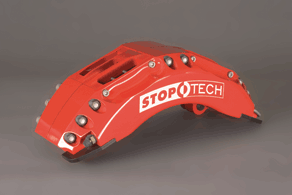
Caliper sizing and selection is generally a function of the required hydraulic gain, with larger calipers providing more output than smaller calipers. For this reason, calipers like this eight-piston monster designed for the Hummer H2 would be complete overkill on a smaller, lighter vehicle. (Randall Shafer/StopTech)
Caliper Components
It has already been stated that the caliper functionally resembles a common master cylinder, but in order to fit around the spinning rotor it must be shaped like a C-clamp. This isn’t necessarily a good thing, as the clamping force generated at the open end of the caliper will always attempt to spread the caliper body apart. This distorts the caliper body, which exaggerates the P-V relationship. In short, more caliper deflection results in more brake pedal travel.
Two significant mechanical attributes of a caliper are its stiffness and its strength. Not to be used interchangeably, stiffness indicates how much deflection a caliper exhibits for a given amount of clamp force, while strength is a measure of the absolute force that can be sustained before failure of the caliper. Consequently, high stiffness is desired for good pedal feel while high strength is required for mechanical integrity.
Body
The caliper body is typically made of cast iron in production vehicles. It locates the piston and supports the clamp force exerted on the brake pads. While cast iron is acceptable from stiffness and strength perspectives (especially at elevated temperatures), its weight makes it undesirable in performance applications. Consequently, aluminum alloys are employed when circumstances dictate the lowest weight possible (in fact, aluminum caliper bodies are nearly universal on modern high-performance vehicles), but their reduced stiffness can lead to excessive caliper deflection without appropriate design countermeasures.
The body consists of three main parts: an inboard body section (which almost always contains at least one piston bore), an outboard body section (which may or may not contain additional piston bores), and a bridge, which connects the two. In some applications, calipers can be fabricated from three separate components, but most often times are combined in a number of creative ways.

Caliper strength and stiffness are two key characteristics for optimum performance. Recent advances in computer modeling and simulation have allowed for significant improvements in both of these areas without the penalty of increased weight. (StopTech)
Hydraulic Gain Example
If a vehicle was designed with a 0.75-inch-diameter master cylinder piston and a 2.00-inch-diameter caliper piston, one could calculate their effective areas as follows:
Diameter (in) Inboard Area (in2) Effective Area (in2)
Master cylinder 0.75 n/a 0.44
Caliper 2.00 3.14 6.28
Recalling from the body text, the hydraulic gain of the brake system is simply the effective area of the caliper divided by the effective area of the master cylinder, or in equation form:
Hydraulic gain (unitless) =
effective caliper piston area (in2)
÷ master cylinder piston area (in2)
Consequently, the hydraulic gain of this system would be 14.2:1 (6.28 square inches divided by 0.44 square inches). In other words, for every pound of force applied to the master cylinder piston, 14.2 pounds of clamp force is generated by the caliper.
The hydraulic relationship also dictates that the linear travel experienced by the master cylinder piston will be 14.2 times greater than the linear travel experienced by the caliper piston relative to the caliper body. For example, if the caliper piston required 0.010 inches of travel to overcome compliance, the master cylinder piston would need to travel approximately 0.142 inches (14.2 times as far) to accommodate the P-V need.

The basic caliper structure consists of body sections and bridge sections. In some applications, these may be discrete components assembled together. In the case of this early Porsche 911 Turbo caliper, two piston housings are bolted to two bridge sections to finalize the caliper assembly. (Randall Shafer)
Bridge Reinforcement
In order to facilitate caliper inspection and brake pad replacement without caliper removal, it’s common to have large openings in the caliper bridge. Unfortunately, these openings can greatly reduce the stiffness of the caliper, resulting in poor brake pedal feel. The term open caliper is often used to describe this type of arrangement.
Consequently, select manufacturers implement an auxiliary bridge reinforcement to regain the stiffness lost by open caliper design. This component is not required with closed calipers where pad replacement is performed by removing the entire caliper body from the vehicle.
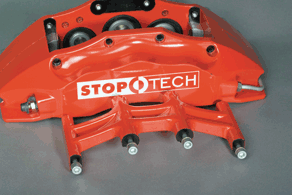
In a closed caliper design, a structural reinforcement connects the inboard and outboard caliper body sections. Based on the manufacturer, it may be a removable piece bolted in place as shown above, or it may be integral to the body assembly. (Randall Shafer/StopTech)
Bracket
Based on the individual design, the caliper body may require a bracket to attach it to the suspension upright, or knuckle. Made from either aluminum or cast iron, the bracket may also serve to locate the brake pads in some applications. In the case of the floating caliper, the bracket also contains parallel channels for the caliper slider pins (more to come in just a few paragraphs) and is most likely designed to support the brake pad friction force as well.

Most calipers require a bracket to attach them to the vehicle suspension. Simple brackets, like the one shown above in yellow, locate the caliper relative to the rotor without performing auxiliary functions. (StopTech)
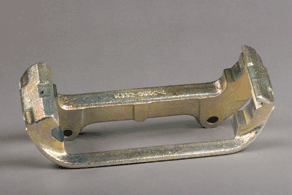
In many applications, the caliper mounting bracket must do much more than simply position the caliper relative to the rotor. For example, the C-shaped channels machined into either end of the bracket shown above serve to locate the brake pads as well as to provide axial (sliding) movement of the entire caliper assembly. (Randall Shafer/Baer)
Abutment Plates
In aluminum caliper applications that need to support brake pad friction force, a pair of brake pad abutment plates are used to provide a durable surface at the sliding interface. These plates are usually fabricated from a thin piece of hard steel and allow for free motion of the steel brake pad backing plates relative to the aluminum caliper body without deformation of the softer body material.
Cast iron caliper bodies, due to their unique mechanical properties, typically do not require abutment plates. Note also that the abutment plates may be located in the caliper bracket in some applications.
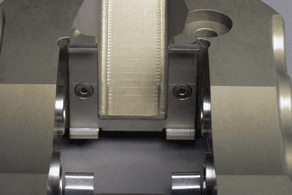
Since most high-performance calipers are fabricated from aluminum, abutment plates should be added to the caliper body to prevent wear at the brake pad interface. Calipers made from cast iron, however, don’t require this additional design feature. (Randall Shafer/Baer)
Piston(s)
The caliper piston (or pistons) transmits hydraulic fluid pressure to the brake pad backing plates. Based on the application, a caliper may have between one and eight pistons, but all function in the same manner. Larger-diameter pistons generate higher forces and smaller diameter pistons generate lower forces.
In most production applications, pistons are fabricated from steel or aluminum. Titanium is used in select racing applications for its low thermal conductivity and decreased weight, but the cost of this material makes it prohibitive on typical production vehicles. Phenolic materials are found in some OEM applications, but their poor resistance to high temperatures makes them generally inappropriate for high-performance use.
Thermal Insulators
In addition to titanium pistons, thermal insulators may be sleeved inside of steel or aluminum pistons to reduce heat transfer from the brake pad backing plate to the piston (and ultimately to the brake fluid). Titanium and ceramic button inserts can be quite effective at keeping heat out of the hydraulic system, and they’re less expensive to manufacture than billet titanium pistons.
Ceramic materials are also applied to the interior surfaces of the caliper body in some racing applications. These exotic coatings are designed to reduce heat transfer from the rotor to the caliper body, and ultimately the brake fluid.